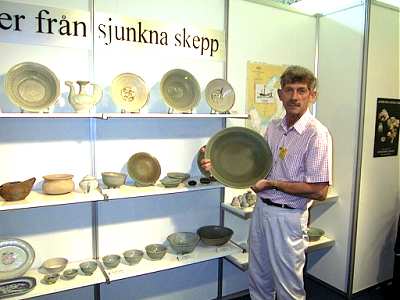
This page is only one of many thousands of Gotheborg.com Help and Information Pages, offering specialized knowledge on Chinese and Japanese Porcelain, including a Glossary, Q&A, Chinese and Japanese Porcelain Marks, Chinese Porcelain Exhibition and Excavation reports etc. For personal help and far more information, join our Discussion Board or use 'Ask a Question' for quick email consultations. For full text and better navigation, use a full-screen device rather than a mobile phone, that offers only limited content.
 You may know that my Chinese pottery knowledge is rather limited whilst Southeast Asian wares always been my favorite. Only one of our wrecks, the Xuande, contained blue and white. Two articles in Oriental Art magazine No 2. 1997 by Roxanna Brown and myself highlights the problem dating these items.
You may know that my Chinese pottery knowledge is rather limited whilst Southeast Asian wares always been my favorite. Only one of our wrecks, the Xuande, contained blue and white. Two articles in Oriental Art magazine No 2. 1997 by Roxanna Brown and myself highlights the problem dating these items.
At least shipwrecks provide new and often conflicting pottery that more often than not upset current knowledge. One common explanation, given by established scholars, is that the wreck in question carried 'antique' ceramics when it sunk. This way safe-guarding current knowledge and chronologies.
My personal view (accepting that some porcelain, like those made during the reign of Xuande, may have been copied as appreciation for the forms and decorations at later times) is that there were no antique dealers 300-400 years ago sending huge loads of porcelain to be traded in Southeast Asia. I do not accept the possibility that the various kilns had such over-capacity or that there were people keeping ordinary provincial wares until antique.
The alternative is of course that we have been wrong in much of our dating and chronologies. Or, that there were in fact many more kilns than those we know today.
I also do not feel that kiln sites or burials are the best sources of information. Waste piles are often disturbed and burials could contain any old piece the deceased happen to have appreciated during his life time. So, shipwrecks is, in my view, the very best source for new discoveries.
Eight years of excavations at the kiln sites at Si-Satchanalai by and joint Thai-Australian team concluded, among other things, that Si-Satchanalai first made "MON" ware, thereafter early green-glazed and then celadon for the export markets. First after the celadon production was established at Si-Satchanalai did the kilns at Sukhothai start with under glaze black decorated wares. It was also reported that Sukhothai only produced and exported a fraction of that of Si-Satchanalai.
At that time we found the Turiang, a wreck now that now is completely investigated. This wreck contained Si-Satchanalai "MON" ware, early green-glazed but no Si-Satchanalai celadons. Instead it had Sukhothai fish and flower decorated dishes by the thousands!
That we were able to date this wreck to third quarter of the 14th century with the help of Chinese celadons and Vietnamese underglaze from the same wreck, again throw the kiln excavation team off by about two centuries.
Point taken?
This season we were also involved in investigating a Chinese blue and white site. The different wares, that you may have seen is in some peoples view 100 years apart. Some say "sometime early 1700" whilst other says mid-Ming..."for sure"
So, until proven otherwise, I feel that wrecks and their cargo, particularly when we can match the actual ships remain with a specific design, type of wood etc., is the best guide dating any pottery.
Sten Sjöstrand
PS. A monograph about the Turiang wreck by Roxanna Brown and myself will be published by The Pacific Asia Museum in April 2000 should you be interested in more contraversies.
Thank you,